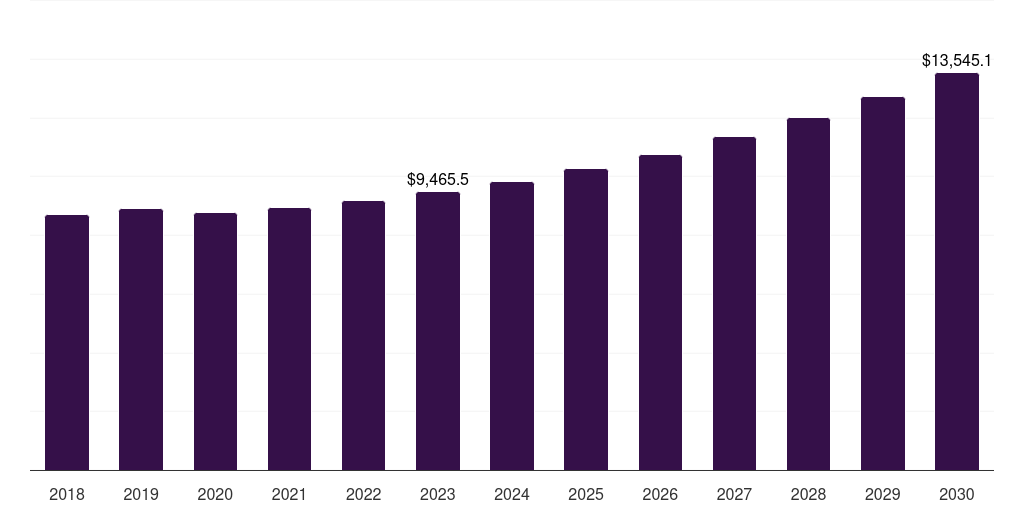Europe Automotive Plastics Market Size & Outlook
Europe automotive plastics market, 2018-2030 (US$M)

Related Markets
Europe automotive plastics market highlights
- The Europe automotive plastics market generated a revenue of USD 9,465.5 million in 2023.
- The market is expected to grow at a CAGR of 5.3% from 2024 to 2030.
- In terms of segment, polypropylene (pp) was the largest revenue generating product in 2023.
- Polycarbonate (PC) is the most lucrative product segment registering the fastest growth during the forecast period.
- Country-wise, France is expected to register the highest CAGR from 2024 to 2030.
Europe data book summary
| Market revenue in 2023 | USD 9,465.5 million |
| Market revenue in 2030 | USD 13,545.1 million |
| Growth rate | 5.3% (CAGR from 2023 to 2030) |
| Largest segment | Polypropylene (pp) |
| Fastest growing segment | Polycarbonate (PC) |
| Historical data covered | 2018 - 2022 |
| Base year for estimation | 2023 |
| Forecast period covered | 2024 - 2030 |
| Quantitative units | Revenue in USD million |
| Market segmentation | Acrylonitrile Butadiene Styrene (ABS), Polypropylene (PP), Polyurethane (PU), Polyvinyl Chloride (PVC), Polyethylene (PE), Polycarbonate (PC), Polymethyl Methacrylate (PMMA), Polyamide (PA) |
| Key market players worldwide | Akzo Nobel NV, Basf SE, Covestro AG, Evonik Industries AG, Adient PLC, Magna International Inc, Momentive, SABIC, Dow Inc, Hanwha, Grupo Antolin, Lear Corporation, Owens-Corning Inc, Quadrant Group, Koninklijke DSM NV, Teijin Ltd |
Other key industry trends
- In terms of revenue, Europe region accounted for 31.1% of the global automotive plastics market in 2023.
- Globally, Asia Pacific is projected to lead the regional market in terms of revenue in 2030.
- Asia Pacific is the fastest growing regional market and is projected to reach USD 20,959.4 million by 2030.
No credit card required*
Horizon in a snapshot
- 30K+ Global Market Reports
- 120K+ Country Reports
- 1.2M+ Market Statistics
- 200K+ Company Profiles
- Industry insights and more
Automotive Plastics Market Scope
Automotive Plastics Market Companies
| Name | Profile | # Employees | HQ | Website |
|---|
Europe automotive plastics market outlook
The databook is designed to serve as a comprehensive guide to navigating this sector. The databook focuses on market statistics denoted in the form of revenue and y-o-y growth and CAGR across the globe and regions. A detailed competitive and opportunity analyses related to automotive plastics market will help companies and investors design strategic landscapes.
Polypropylene (pp) was the largest segment with a revenue share of 31.47% in 2023. Horizon Databook has segmented the Europe automotive plastics market based on acrylonitrile butadiene styrene (abs), polypropylene (pp), polyurethane (pu), polyvinyl chloride (pvc), polyethylene (pe), polycarbonate (pc), polymethyl methacrylate (pmma), polyamide (pa) covering the revenue growth of each sub-segment from 2018 to 2030.
European automobile manufacturers are shifting to the use of plastic components as these are energy efficient and help in the reduction of vehicle weight. Furthermore, automotive plastics also provide design flexibility, resiliency, high performance at low costs, toughness, durability, and are corrosion resistant. Automotive sector is the third-largest consumer of plastics in Europe.
Increase in electric vehicle production in Europe is expected to drive the growth in the automotive plastics market. As automotive plastics are widely used to manufacture electric vehicle parts such as casing & non-moving parts, energy recovery devices, fans, pumps, and others. Interior furnishing is a dominant application segment for automotive plastics in the region.
Plastics have replaced glass windows and lights as the former are stronger and lighter in nature. Rear bumper of a vehicle made up of plastic has nearly replaced 13 functions of the earlier aluminum bumper system. The use of plastics for car exteriors have helped in the weight reduction of the cars.
Reasons to subscribe to Europe automotive plastics market databook:
-
Access to comprehensive data: Horizon Databook provides over 1 million market statistics and 20,000+ reports, offering extensive coverage across various industries and regions.
-
Informed decision making: Subscribers gain insights into market trends, customer preferences, and competitor strategies, empowering informed business decisions.
-
Cost-Effective solution: It's recognized as the world's most cost-effective market research database, offering high ROI through its vast repository of data and reports.
-
Customizable reports: Tailored reports and analytics allow companies to drill down into specific markets, demographics, or product segments, adapting to unique business needs.
-
Strategic advantage: By staying updated with the latest market intelligence, companies can stay ahead of competitors, anticipate industry shifts, and capitalize on emerging opportunities.
Target buyers of Europe automotive plastics market databook
-
Our clientele includes a mix of automotive plastics market companies, investment firms, advisory firms & academic institutions.
-
30% of our revenue is generated working with investment firms and helping them identify viable opportunity areas.
-
Approximately 65% of our revenue is generated working with competitive intelligence & market intelligence teams of market participants (manufacturers, service providers, etc.).
-
The rest of the revenue is generated working with academic and research not-for-profit institutes. We do our bit of pro-bono by working with these institutions at subsidized rates.
Horizon Databook provides a detailed overview of continent-level data and insights on the Europe automotive plastics market , including forecasts for subscribers. This continent databook contains high-level insights into Europe automotive plastics market from 2018 to 2030, including revenue numbers, major trends, and company profiles.
Partial client list
Europe automotive plastics market size, by country, 2018-2030 (US$M)
Europe Automotive Plastics Market Outlook Share, 2023 & 2030 (US$M)
Related regional statistics
Sign up - it's easy, and free!
Sign up and get instant basic access to databook, upgrade
when ready, or enjoy our
free plan indefinitely.
Included in Horizon account
- 30K+ Global Market Reports
- 120K+ Country Reports
- 1.2M+ Market Statistics
- 200K+ Company Profiles
- Industry insights and more



